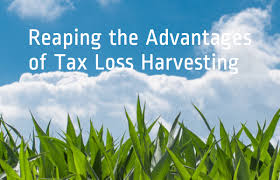April marks the start of Financial Literacy Month, a nationally recognized movement to promote and support financial understanding in children and teens. For many, it's a fantastic opportunity to teach and connect with their children or grandchildren...
[+] Full Article 2023 Changes to Iowa's Retirement Taxes - 03/01/23
In March of 2022 Iowa Governor Kim Reynolds signed a historic Iowa tax reform bill. One of the biggest changes from the bill is that starting in 2023, Iowans aged 55 or older are exempt from paying state taxes on retirement income...
[+] Full Article
Tax-Loss Harvesting

August 16, 2017
A useful year-end move to counteract capital gains.
It looks like 2017 will end up being a very good year for the stock market. Consequently, you may realize short-term capital gains. What will you do about them? You could do what many savvy investors do – you could “cash in your losses” and practice “tax-loss harvesting.”
Selling losers to offset winners. Tax-loss harvesting means taking capital losses (selling securities worth less than what you first paid for them) to offset the short-term capital gains you have amassed.
While this doesn’t get rid of your losses, it can mean immediate tax savings. It can also help you diversify your portfolio. It may even help you to position yourself for better long-term, after-tax returns.
The tax-saving potential. Sure, you can use this technique to put your net gains at $0, but that’s just a start. Up to $3,000 of capital losses in excess of capital gains can be deducted annually, and any remaining capital losses above that can be carried forward to offset capital gains next year.1
So, by taking a bunch of losses this year, and carrying over the excess losses into 2017, you can potentially shelter some (or maybe all) of your long-term and short-term capital gains next year. This gives you a chance to shelter winners you’ve held (even for less than a year) from being taxed at up to 39.6%.2
The strategy in action. It is really quite simple. Step A is to pick out the losers in your portfolio. Step B is deciding which losers to sell. Step C is giving the green light to those transactions.
You must watch out for the IRS “wash-sale” rule, however. You can’t claim a loss on a security if you buy the same or “substantially identical” security within 30 days before or after the sale. (The window is actually 61 days wide in some instances.) In other words, you can’t just sell a security to rack up a capital loss and then quickly replace it.3
But you may be able to avoid the wash-sale rule by using an ETF to make a tax swap: an ETF for a stock or mutual fund, or perhaps an ETF for another ETF, as long as the ETFs are linked to different indices. Although these tax swaps are widely done, this is still something of a gray area, so consult a qualified tax professional first.1
Watch the fine print on wash sales. The wash-sale rule applies to your entire taxable portfolio, not just one taxable account within it. So, as an example, if you sell individual holdings of stock in a company, you still must wait for the wash-sale window to close before you can purchase shares of that same firm for your IRA. Also, the wash-sale rule applies to multiple taxable accounts – worth remembering if you and your spouse file your taxes jointly. If you sell a loser and your spouse or a corporation you control purchases the same investment within the time frame, you could violate the rule.3,4
The (minor) drawbacks. You may not wish to alter a carefully chosen portfolio to the degree that you must for tax-loss harvesting, especially if it has been built for the long term. Also, you could end up missing a rally in which an investment you have sold might take off.
You can only practice tax-loss harvesting in taxable accounts; tax-advantaged accounts are ineligible for this strategy. Transaction costs do add up, so think about those costs versus the potential savings before you begin – or alternately, harvest losses within a fee-based account.5
Not just a year-end tactic, but also a year-round strategy. Some investors harvest losses throughout the year, not just in December. You may want to ask the financial professional you know and trust how you can harvest losses this holiday season and beyond.
This material was prepared by MarketingPro, Inc., and does not necessarily represent the views of the presenting party, nor their affiliates. This information has been derived from sources believed to be accurate. Please note - investing involves risk, and past performance is no guarantee of future results. The publisher is not engaged in rendering legal, accounting or other professional services. If assistance is needed, the reader is advised to engage the services of a competent professional. This information should not be construed as investment, tax or legal advice and may not be relied on for the purpose of avoiding any Federal tax penalty. This is neither a solicitation nor recommendation to purchase or sell any investment or insurance product or service, and should not be relied upon as such. All indices are unmanaged and are not illustrative of any particular investment.
«RepresentativeDisclosure»
Citations.
1 - smartasset.com/taxes/all-about-tax-loss-harvesting [4/15/17]
2 - marketwatch.com/story/how-to-pay-less-in-taxes-on-your-investments-2017-05-31/ [5/31/16]
3 - thebalance.com/wash-sale-rule-3192972 [5/31/17]
4 - cnbc.com/2016/12/08/what-to-know-before-you-harvest-your-2016-tax-losses.html [12/8/16]
5 - doughroller.net/reviews/schwab-intelligent-portfolios/ [7/11/17]



